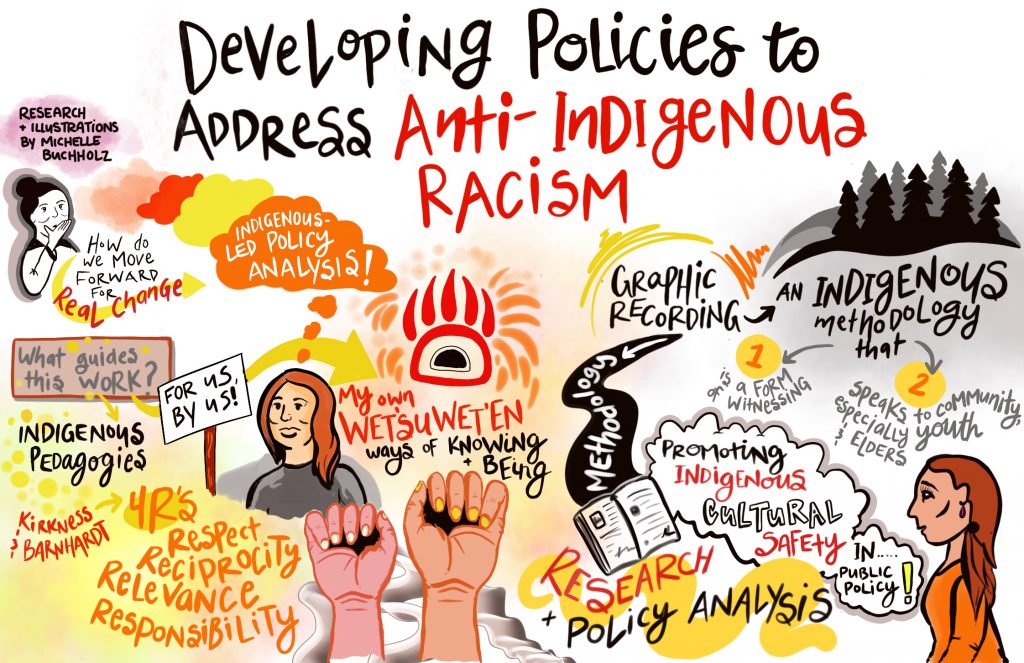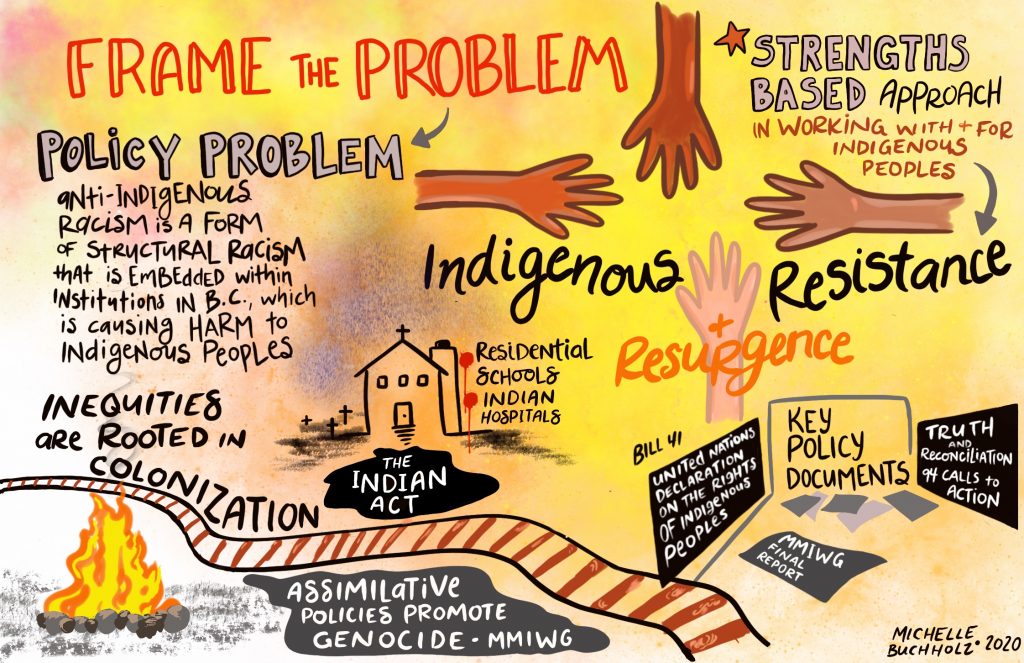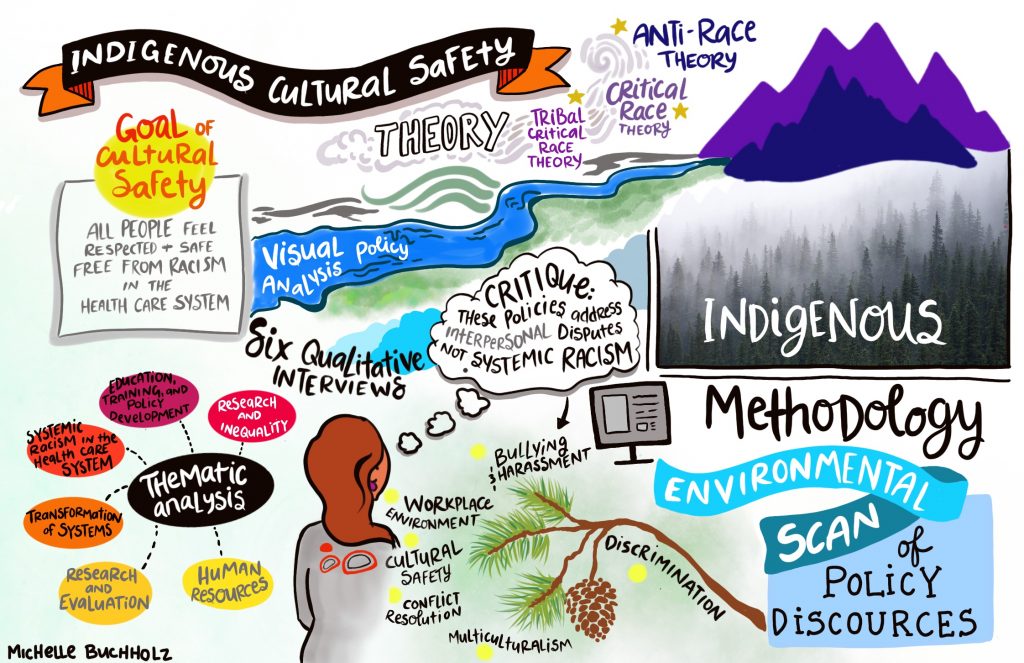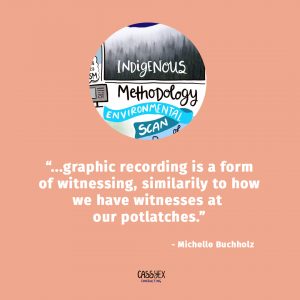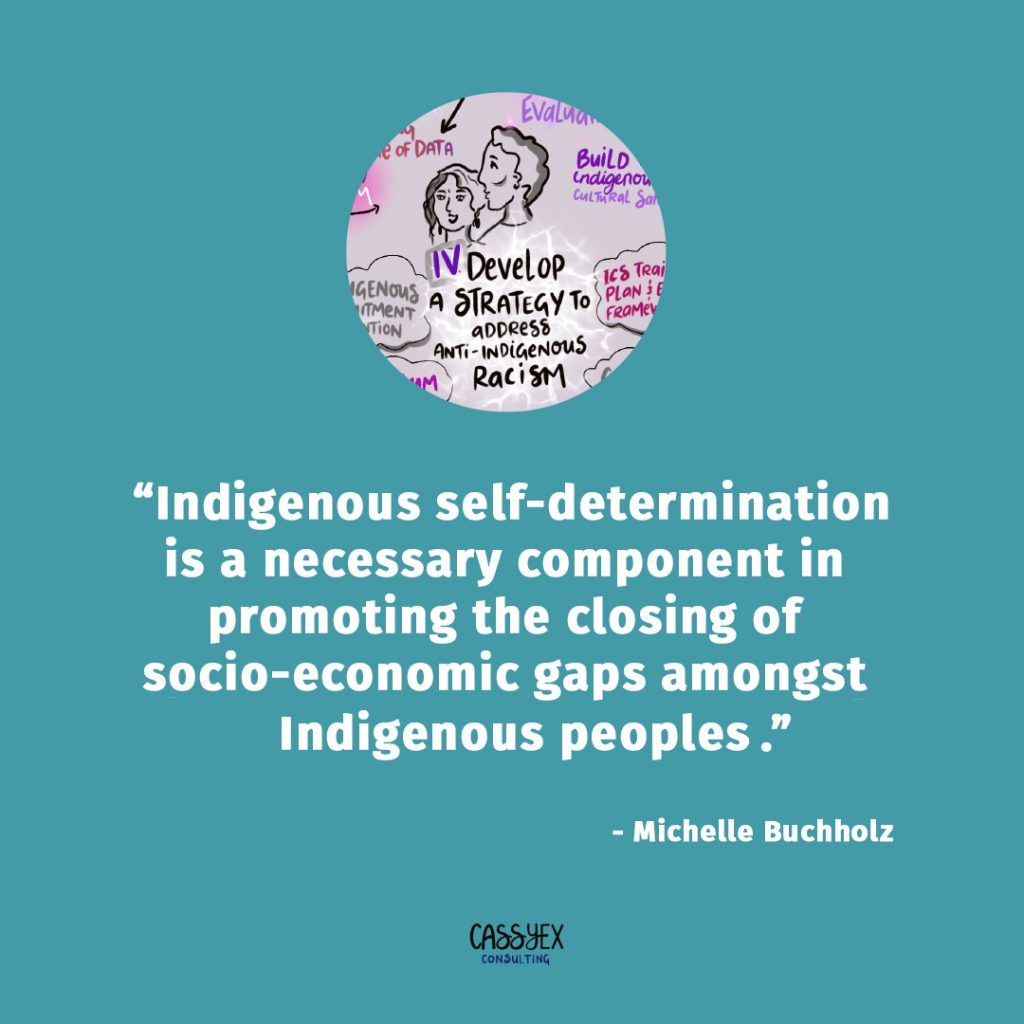
Visual Policy Analysis: Developing Policies to Address Anti-Indigenous Racism
Join us on *second date added* July 8th, 1pm PST for a WEBINAR facilitated by Michelle Buchholz: “Visual Policy Analysis: Developing Policies to Address Anti-Indigenous Racism”.

Had’ih, Michelle Buchholz sozi.
I am Wet’suwet’en from the Gitumden clan and the Cassyex house. My maternal grandmother is the late Joyce Alec and my paternal grandmother is the late Christine Buchholz. I was raised outside of Smithers, B.C on my clan territories. I work as a graphic recorder/facilitator, a qualitative researcher, and a visual policy analyst on the unceded territories of the Musqueam, Squamish, and Tsleil-Waututh people.
In 2019, I completed a Master of Public Policy at SFU and wrote a capstone project entitled “Developing Policies to Address Anti-Indigenous Racism in Health Care”.

Graphic Recording as a Methodology
I utilized graphic recording as a methodology and successfully defended my capstone using my own graphic recording. I re-drew my capstone research and my hope is that it may serve as a tool that can be used by both Indigenous and non-Indigenous groups to inspire research and analysis of their own policies to address anti-Indigenous racism. I call this process visual policy analysis. I offer this service as a methodology to help Indigenous and non-Indigenous organizations, governments and groups visualize their policies.
Developing Policies to Address Anti-Indigenous Racism
Dialogue around anti-Indigenous racism must highlight the reality that Indigenous peoples are often excluded from policy decision making tables within organizations and institutions. If we are included, it is common that we are dismissed or tokenized at these tables, wherein our sharing of knowledge and lived experiences are not taken seriously, thus not incorporated into final reports and policy documents.
This in turn creates a lack of trust and builds barriers towards relationship building with Indigenous communities and organizations. Thus, my hope is that this document inspires organizations and institutions to place greater importance on meaningfully involving Indigenous peoples in policy-decision making and building specific contractual strategies towards addressing anti-Indigenous racism.
Reframing the Problem
This work explores policy practices that can assist in reducing harm faced by Indigenous peoples. I wanted to look at policies that address anti-Indigenous racism within institutions in B.C. Many policy conversations are rooted in mainstream Eurocentric knowledge, which doesn’t resonate with me.
I wanted to take an Indigenous approach to my work and highlighted my own identity as a Wet’suwet’en woman. I argued that being objective in research is not desirable because my lived experience with anti-Indigenous racism plays an important role in this work.
Public policy is written by first framing a “problem”. I wrote that anti-Indigenous racism is a form of structural racism that is embedded within institutions in B.C. which is causing harm to Indigenous peoples. I intentionally highlighted that Indigenous people are experiencing harm as we’re often (wrongfully) framed as the problem in policy contexts.
Indigenous Cultural Safety
I also highlighted the use of a strengths-based approach. This approach focuses on strengths and resiliency within our communities and resistance to colonialism.
Policy Analysis
The work of Indigenous scholars and the tenets of critical race theorists guided my work. Critical race theorists state that racism is endemic to society and Bryan Brayboy who wrote Tribal Critical Race Theory states that colonization is endemic to society. Indigenous people who I’ve worked with told me that graphic recording is a form of witnessing, similarly to how we have witnesses at our potlatches. I envision this methodology as both a form of witnessing, but also as a marrying of theory and practice. I call this a more Indigenous way of doing policy because it made my work more impactful and shareable to the community.
This final image shows my analysis and the policy strategies that I propose as solutions. The policy strategies include collecting racial equity data, an Indigenous recruitment, retention and support program, mandatory Indigenous cultural safety training, and to develop a strategy to address anti-Indigenous racism. I recommended implementing all of the policy options on a short-term and long-term basis.
Anti-Indigenous racism is engrained within the structures of our institutions and it is important to acknowledge the limitations that individual policies may have in reducing the harm that Indigenous peoples face. This recommended policy package is expected to help reduce anti-Indigenous racism and reduce inequities between Indigenous and non-Indigenous peoples, yet fundamental change is needed in our social structures in Canada. Indigenous self-determination is a necessary component in promoting the closing of socio-economic gaps amongst Indigenous peoples.
Sne kal yëgh (thank you) for reading this document and considering ways that we can reduce anti-Indigenous racism!
To learn more, get in touch with Michelle at michelle.cassyex@gmail.com, and her website: www.cassyexconsulting.com
◊ ◊ ◊
WEBINAR
Join us on *second date added* July 8th, 1pm PST for a longer, in-depth WEBINAR facilitated by Michelle Buchholz: “Visual Policy Analysis: Developing Policies to Address Anti-Indigenous Racism”.
*FULL* Join us on June 23rd at 1pm PDT for a free webinar facilitated by Michelle Buchholz: “Visual Policy Analysis: Developing Policies to Address Anti-Indigenous Racism”. Register on Eventbrite here.
(6MB FILE) Download this post as a PDF: Visual Policy Analysis – Michelle Buchholz
Further Resource List:
Brayboy, B. M. J. (2005). Toward a tribal critical race theory in education. The Urban Review, 37(5), 425–446.
https://dx.doi.org/10.1007/s11256-005-0018-y
Brian Sinclair Working Group. (2017, September). Out of sight: Interim report of the Brian Sinclair working group. Retrieved from http://ignoredtodeathmanitoba.ca/index.php/2017/09/15/out-of-sight-interim-report-of-the-sinclair-working-group/
Fridkin, A. J., Browne, A. J., & Dion Stout, M.K.(2019). The RIPPLES of meaningful involvement: A framework for meaningfully involving Indigenous Peoples in health policy decision-making. The International Indigenous Policy Journal, 10(3). doi:
https://doi.org/10.18584/iipj.2019.10.3.8309
Indigenous Cultural Safety Collaborative Learning Series (Webinars) Retrieved from http://www.icscollaborative.com/webinars
Lawrence, B., & Dua, E. (2005). Decolonizing anti-racism. Social Justice. 32(4), 120–143. Retrieved from
http://www.racialequitytools.org/resourcefiles/bonita-lawrence-decolonizing-anti-racism.pdf
This project was funded and supported by Drawing Change
Copyright © 2020 Michelle Buchholz, Cassyex Consulting, All Rights Reserved.
You may share this work with credit. You may not change this work in any way or use it for commercial purposes.

